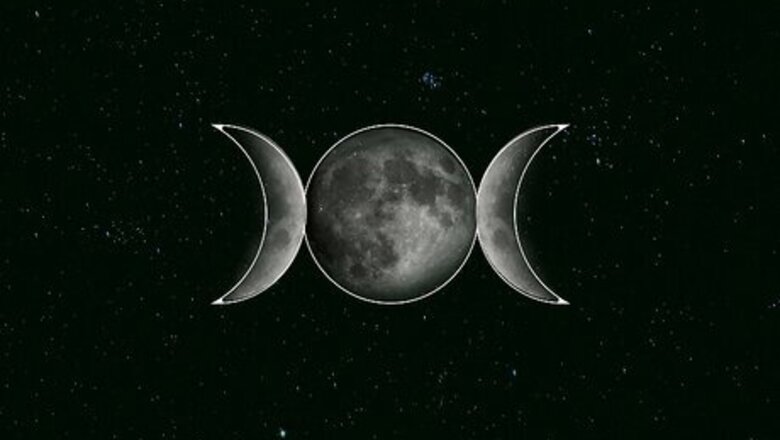
views
Symbols of Feminine Strength and Courage
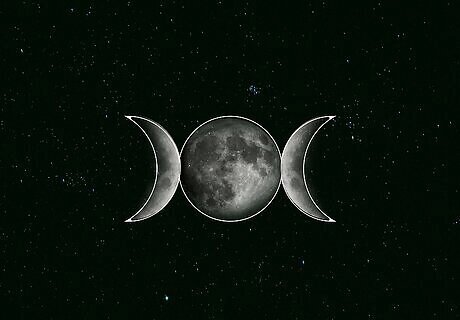
Triple goddess (Wiccan) The triple goddess (also called the triple moon) is an important Wiccan symbol that shows the three phases of the moon (waxing, full, and waning) directly next to each other. Each of the phases links to the three feminine archetypes, symbolizing each woman's life and the cyclical nature of life itself. The maiden (waxing moon): Youth, beauty, innocence, optimism, and new possibilities. The mother (full moon): Fertility, nurturing, protection, and self-care. The crone (waning moon): Wisdom, power, and death.
Lotus flower (India) The meaning of lotus flowers varies across cultures and countries, but they’re typically associated with purity, rebirth, and persistence. In Hinduism, the lotus is often associated with the divine feminine and is also a symbol of the creative power of the goddess Shakti. In Hinduism, pink lotuses symbolize delicate feminine energy, while red lotuses in Buddhism represent the fiery passion of Padma, one of the five Buddha families.
Hathor’s crown (Ancient Egypt) Hathor is the Ancient Egyptian goddess of motherhood and fertility. Associated with water, she was believed to be responsible for the yearly flooding of the Nile River and for each pregnant woman’s water breaking. Her symbol appears as a sun disk between the horns of a cow. Hathor was often worshiped and represented as a cow because it was an Egyptian symbol of motherhood. Other symbols represent her as a woman with a fringe of hair at the top of her head between her two horns, like a cow typically has.

Mokosh (Slavic) In Ukrainian and Slavic mythology, Mokosh is the mother of all things living on earth and a symbol of rejuvenation and fertility. She was also known as a protector and patron of women. Her symbol typically looks like an X with boxes inside each quarter. Some even call Mokosh the Great Goddess, or Fate, because she sheared sheep and spun flax and wool (or “life’s thread”) at night. Her name comes from the word mokryi, meaning “moist,” and because of this, she was often connected to the moisture-giving power of the earth.
Swans (Ancient Greece) In folklore all around the world, swans are a symbol of feminine energy, grace, strength, and loyalty. In Greek mythology, the goddess Aphrodite was sometimes seen with a swan as a symbol of good health, divination, music, and grace. Apollo, the god of light, music, and poetry, was also often shown riding a chariot pulled by swans.
Venus symbol The Venus symbol (♀) is one of the most widely recognized symbols for women. In ancient Greece, Venus and Mars (representing men) symbols were used in alchemy to represent copper and iron. Today, the Venus symbol is a symbol of strength, representing the fight for women’s equality and empowerment. Some variations of the Venus and Mars (♂) symbols are used to represent sexual orientation. For example, a double Venus symbol (⚢) represents lesbianism.
Spiral Goddess (Western Pagan) Spirals often symbolize growth, expansion, and progress. The Spiral Goddess symbol was inspired by ancient female figurines from archeological sites and represents the cycle of life and death, the divine feminine, creation, nature, strength, and energy. This goddess is associated with the Western Pagan “Goddess Movement,” which was founded by women and worships the divine feminine.
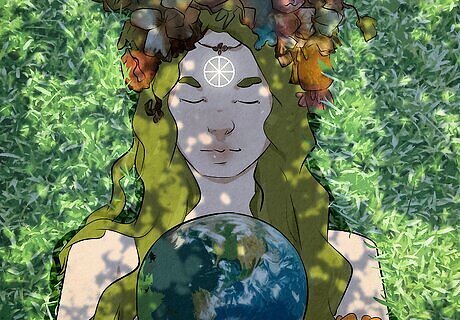
Gaia (Ancient Greece) In Greek mythology, the world was created when Gaia (Goddess of the Earth) came out of Chaos, or nothingness. She then gave birth to Ouranos (the sky), Pontos (the sea), Ourea (the mountains), and the 12 Titans. As the life force of the planet, Gaia is often represented by the planet Earth or the Wheel of the Year. The spiral goddess is also sometimes used as a symbol of Gaia. Two of the Titans were Cronus and Rhea, who were the parents of Zeus, the King of the gods.
Motherhood Knot (Celtic) Motherhood takes a kind of strength and courage that can never be broken. That’s what the Celtic motherhood knot symbolizes. This knot is a variation of the Triquetra or trinity knot and represents the unbreakable, never-ending bond between mother and child. Traditionally, the motherhood knot is shown as two interlinked hearts, with no start or finish between them. However, some modern knots might have 5 or 6 hearts. The dara knot, one of the most popular Celtic symbols of strength, is also used to symbolize the bond between mother and child.
Durga Goddess (Hinduism) In Hinduism, Shakti is a powerful female energy that is responsible for the creation, maintenance, and destruction of the universe. The goddess Durga is the warrior aspect of this energy and is linked with strength and protection. Most Durga symbols are an outline of her eyes, nose, mouth, nose ring, and a third eye on her forehead. To represent Shakti, some might use a lotus, a Sri Yantra (a geometric symbol), or a trishula (a three-pronged spear associated with Shiva, the male counterpart of Shakti).
Berkano Rune (Scandinavia) The Berkano rune is related to the mother of all things, the Earth Goddess. This ancient rune symbolizes family and a strong feminine presence. It’s also associated with protection, new beginnings, women’s power, love, and healing. Birch trees are often associated with this rune because they represent fertility, growth, sustenance, renewal, and good fortune. The Berkano rune, which is also used as the Bluetooth symbol, appears as a breast that has been turned sideways.

The moon Across cultures and countries, the moon is known as a feminine symbol because of its monthly cycle, which mirrors the menstrual cycle of women. In some African societies, the moon is also linked to life itself because the lunar cycles line up with female fertility, agricultural growth, and ritual calendars. In Christianity, Mary is called the moon who gets grace and glory from her son Christ, the eternal sun. The moon is also a sign of constant change and moral instability. Women are also associated with water, partly because the moon pulls and controls the tides of the ocean.
Owl of Athena (Ancient Greece) In Greek mythology, Athena was the goddess of wisdom, war, heroism, and crafts. Athena inspired and fought alongside other Greek heroes, showing off her military prowess while letting her intelligence and virtue of justice guide her decisions in battle. Athena is usually symbolized by an owl because Athena used to keep an owl on her shoulder who revealed truths of the world to her. This is also why owls are associated with wisdom. Athena is also associated with the olive branch symbol because she struck the ground of the city of Athens (named after her) with her spear, causing an olive tree to grow.
Scallop shells (Ancient Rome) Venus was the Roman goddess of gardens and cultivated fields, and later was associated with the Greek goddess of love, Aphrodite. The most famous painting of her is Sandro Botticelli’s The Birth of Venus, which shows her as the goddess of love and beauty arriving on land on top of a scallop shell. Venus later symbolized the Roman Empire’s imperial power and in some statues, she represents military success and peace. Some say that the shell is a clam or oyster shell, however, a lot of historians have identified it as a scallop shell.
Lioness Lions typically symbolize courage, majesty, and strength, and lionesses are no different. Spiritually and historically, lionesses are a reminder to embrace all aspects of femininity, from the nurturing and protective to the powerful, fierce, and independent. Ishtar, the Mesopotamian goddess of sex and war, stands on the back of lions, holding symbols of justice and civic authority. The ancient Egyptian goddess Sekhmet was often seen with the head of a lion to represent her ferocity and destructive power.

Asase Ye Duru (Ghana) Asase Ye Duru is an Adinkra symbol or a symbol of the Akan people of Ghana that represents certain concepts or sayings. This symbol represents the saying, “the Earth has no weight,” which symbolizes power, guardianship, and the divine presence of Mother Earth. Asase Ye Duru means that people should respect, preserve, and nurture the Earth, and never act in ways that harm it. The symbol appears as a heart with another heart upside-down on top of it. The two humps of the hearts curl inside the shapes.
Dragons (Ancient East Asia) In Ancient East Asia, dragons were linked with the masculine “yang” part of yin yang, which represents heat, light, and action. However, dragons are also paired with compassionate women like Quan Yin and St. Mary Magdalene—this is why some believe dragons balance masculine and feminine energy. “Dragon lady” is also used as a negative stereotype to describe a manipulative and untrustworthy Asian American woman. Some women might reclaim the dragon to combat this unjust stereotype.
Hamsa (the Hand of Fatima) The hamsa is a symbol of a hand with an eye in the center. It traditionally represents protection, strength, spirituality, good luck, peace, and health. Because the hamsa has been associated with women from various cultures and religions (like Fatima, Miriam, and Mary), some believe the symbol is related to the divine feminine. The divine feminine is the idea that there’s a feminine counterpart to patriarchal and masculine worship systems. It often represents fertility, growth, and intuition. In religious art, women were often depicted warding off evil and defending their homeland with an open right hand. This is why the hamsa also represents justice, fairness, and protection.
Butterfly Artists, writers, and musicians all around the world have used the butterfly’s metamorphosis from a caterpillar as a symbol of change, transformation, and rebirth. This light delicate creature also represents hope, bravery, growth, freedom, and positive change. For women, the butterfly is a symbol of transformation and intuition. In some sub-Saharan African cultures, a butterfly’s metamorphosis is a symbol of transformation when it comes to female puberty or societal change.

The Tyet (Ancient Egypt) The Egyptian goddess Isis wore an amulet known as the “tyet.” After her husband Osiris died, Isis became a protector of the dead and guarded the organs of deceased people during the time of judgment. Isis was not only a loving wife and mother but a powerful immortal being who could resurrect the dead. The tyet (sometimes called the knot of Isis) is a knotted cloth that symbolizes protection in the afterlife. It was typically made of blood-red stone and placed at a deceased person’s neck.
Tiger (Ancient China and Japan) In art, the tiger often symbolizes the “yin” part of yin yang, which includes feminine elements like darkness, water, wind, and the earth. The tiger is a symbol of protection and guardianship, using her quiet strength to balance out yang’s masculine energy. In Japan, mirrors were decorated with feminine symbols like tigers and given as wedding gifts to brides.
Ghanta (Tibetan Buddhism) In Tibetan Buddhist ceremonies, the ghanta, or bell, is used to symbolize the female principle of wisdom or intelligence, emptiness, reality, and ultimate truth. The bell often has lotus petals or five prongs at the top, which symbolize the five female buddhas and eight bodhisattvas. The sound of the bell represents the empty nature of all things, which allows you to be free of attachment and liberated from the painful cycle of birth and death. The ghanta is used alongside the vajra, a five-pronged ritual object that symbolizes the male principle of fitness of action. Together, the two objects represent the path to enlightenment.
The Eye of Horus (Ancient Egypt) The Eye of Horus is an ancient Egyptian symbol of protection, health, and restoration. According to myth, the god Horus lost his eye in battle with the god Seth. The goddess Hathor magically restored it, symbolizing rebirth and the power of healing. Hathor was also the goddess of beauty, sensuality, music, dancing, and maternity. An Eye of Horus amulet was believed to protect and transfer the power of regeneration to the wearer.

Cats (Britain and the U.S.) In the 1800s and early 1900s U.S. culture, women were associated with animals that were believed to be passive, like cats. Anti-suffragette ads in Britain even used cats to say that women were simple and delicate. In both countries, cats were reclaimed by suffragettes, becoming icons of strength and resilience against adversity. In England, cats were put on posters, postcards, and cartoons demanding the right for women to vote. Cats are also popular feminine symbols in other cultures, like ancient Egypt.
Spider Grandmother or Woman (Native American Tribes) Many Native American tribes tell stories of the Spider Grandmother or Woman, an entity that creates new life and protects humanity. According to Ojibwe tribe legend, the grandmother protected a spider from being killed by her grandson, and in return, the spider weaved her a dreamcatcher. In an alternate story, the Spider Woman protected infants and adults. When the job became too large, women were asked to weave dreamcatchers with webs and charms to protect infants. In Hopi legend, a spider named Spider Grandmother created humans out of clay and led them to Earth. In Navajo stories, Spider Woman is not the creator of humans but taught people weaving and agriculture.
Medusa (Ancient Greece) In Greek myth, Medusa was a mortal Gorgon monster with tusks, wings, a head of hair made out of snakes, and a stare that could turn anyone to stone. The Roman poet Ovid later wrote her as a beautiful woman who had a curse put on her by Minerva, who saw Neptune sexually assault her. Now, Medusa is a powerful feminist icon. Medusa has since been reclaimed as a tragic figure who was victim-blamed because punishing a male god would have been unthinkable. Although there are some hints about Medusa once being a beautiful woman in the original myth, it wasn’t until Ovid wrote his version that this narrative became popular. When the hero Perseus cut off Medusa’s head, it was given to Athena to put on her shield. Her strength then became Athena’s strength.
Pele (Hawai’i) Pele, or Pelehonuamea, is the goddess of fire and volcanoes in Hawaiian tradition. In some stories, Pele is a beautiful young or old woman who travels the lands—refuse her requests, and suffer her wrath. Pele is revered and respected. She is both creative and destructive, making new lands but also destroying what’s already there. In Hawaiian tradition, it’s customary to ask permission from Pele to travel through her sacred volcanic lands.
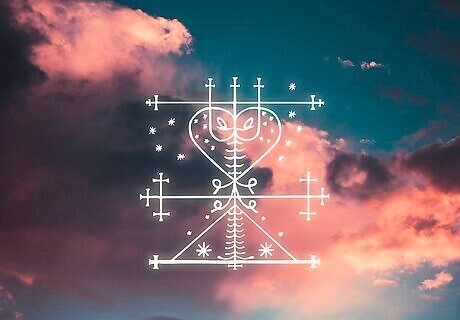
Maman Brigitte (Haitian voodoo) Maman Brigitte (Mother Brigitte) is a female loa of life and death in African Voodoo. She’s a loving protector who guides you through death’s journey if you’re ready, and if it’s not your time, she’ll nurse you back to health. She takes care of cemeteries and graves, drinks rum, swears, and is often symbolized by a black rooster. Roosters represent the sun and dawn—the rebirth we experience every day. Roosters are also a symbol of divinity and are believed to chase away darkness. Although Maman Brigitte is most well-known from Haitian voodoo, she originated in Great Britain as St. Brigit, the Celtic goddess of smithcraft, healing, and poetry.
Circles The circle is a universal symbol that represents wholeness, infinity, cyclical movement, and perfection. Because of the cyclical nature of menstruation, the wholeness of the soul, and the encircling of water as it drains, women and femininity are often tied to this mysterious shape. The circle also represents potential, or the embryo, which ties it back to women’s creation of life. In genetics, the circle is used to represent women, and this gender symbol is sometimes used as an alternative to the Venus symbol.
Calabash (West African tradition) Calabashes (or bottle gourds) have been used for over ten thousand years as food, fishing floats, musical instruments, and water jugs. West and Southern African women found revolutionary ways to use these gourds, including using the chalk of the plant as a remedy for morning sickness. Calabashes have been tied to Yoruban women, who carry gourds filled with water in stories and see the female body as a vessel of creative or destructive power.

Baba Yaga (Slavic folklore) Baba Yaga is a hag who lives in a forest hut that stands on birds’ legs, cooks and eats children, and rides through the air in an iron kettle or a mortar and pestle. In some stories she’s a villain, but in others, she’s a clever, wise, powerful, cunning almost-hero who has been reclaimed as a feminist icon. Instead of fitting the “mother” stereotype by nurturing children, Baba Yaga eats them. She lives by her own magical terms, and although she lives in a house, she’s never “tied down.” Some believe that Baba Yaga was a version of Persephone, the Greek goddess of spring and nature.
Fern (Europe and the U.S.A.) Ferns are flowerless green plants that symbolize hope, peace, and endurance. The fern is often put with fiddleheads, their young curled spiral form, which can be eaten and is believed by some to have healing properties. Together, they represent groundedness, growth, and learning for all women. It’s believed that early peoples didn’t understand how ferns reproduce because they didn’t have flowers or seeds, so the plants became associated with magic and eternal life. “Fern” is also used as a girl’s name. It comes from the Anglo-Saxon word “fearn,” meaning “feather.”
Snake Since Eve’s eating of the apple in the Garden of Eden, snakes in Christian tradition have been associated with lies, evil, and temptation. However, in other cultures, snakes symbolize fertility, rebirth, renewal, and immortality, which are all traits that are also associated with strong and courageous women. In the ancient Minoan society in Crete, the Snake (or Earth) Goddess is often connected with sexuality, fertility, regeneration, the underworld, and healing powers. The Hopi Native American tribe performs a sacred ritual Snake Dance to encourage rainfall and fertility to the land.
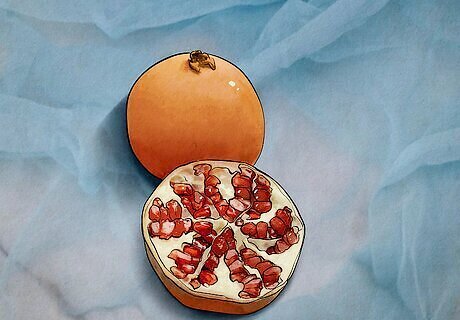
Pomegranate (Ancient Greece) In Greek myth, Persephone was kidnapped by Hades, the god of the underworld. Zeus commanded Hades to release Persephone, but because she had eaten a pomegranate seed in the underworld, she had to spend ⅓ of the year with Hades and the other ⅔ with her mother, Demeter, the goddess of agriculture. Like with Medusa, modern feminists have said that Hades’ non-consensual romantic and sexual relationship with Persephone made her a victim. In other cultures, pomegranates symbolize life, fertility, barrenness, and death. This story was believed to explain why Greek fields were barren after harvest and before the arrival of fall rains, when crops were sown.
Red lipstick (U.S.A.) Red lipstick has been used throughout history, but only gained popularity in the U.S. after World War I when the push-up lipstick tube was invented. When suffragettes marched for the right to vote, they wore red lipstick. During World War II, the bright cosmetic came to symbolize strength, power, and sexuality for women. In WWI, women also entered the workforce and could earn their own money for the first time. Red lipstick was a cosmetic symbol that women could buy something with their own dollars. Today, red lipstick is still associated with feminism, confidence, and power. However, it also was, and still is, viewed as scandalous and overly sexualized.
Rosie the Riveter (U.S.A.) Rosie was the star of a World War II ad campaign in the U.S. to try and get women to enter the workforce, especially in the aircraft industry. The most famous poster features Rosie with her arm flexed and the headline “We Can Do It!” After the war, Rosie became a symbol of personal and financial freedom for women. Millions of women who worked in factories, shipyards, and other places in defense production during WWII are celebrated for their strength and perseverance and are still celebrated today.
Divine Feminine Traits and Characteristics

Intuition Feminine energy is intuitive, wise, and collaborative. You make decisions based on your gut feelings rather than logical reasoning, leading to more creative thinking as you come up with innovative solutions to ordinary problems. Divine feminine and masculine traits can’t exist without the other, and are necessary to balance masculine qualities like action-orientedness, analysis and logic, and independence. Everyone can access their inner divine feminine, regardless of gender.
Beauty A woman’s beauty is often seen as a source of inner strength and courage. However, this beauty isn’t just skin deep. Divine feminine energy is kind, gentle, and forgiving, promoting a deep connection to other people and the universe that can only be described as beautiful. To connect with your inner beauty, try to recognize, acknowledge, and process your emotions to channel empathetic and passionate energy within you.
Passion Passion, sexuality, sensuality, and love have long been seen as symbols of divine female strength. By embracing your sexual desires and focusing on physical pleasures like textures or smells, the divine feminine can help you be more present, indulge in things that excite you, and appreciate your body. Self-care and wellness practices like meditating or lighting a candle can help you get in touch with your body and connect with the world around you on a more present level.

Fertility Women throughout history have been compared to the Earth as symbols of fertility and growth because of their powerful ability to create new life. The divine feminine is all about grounding yourself to the earth, nurturing your body, and tapping into your creativity to make something new. Connect with the natural world by taking a walk, doing some gardening, or just sitting in the grass and watching the clouds go by.
Grace Someone who has grace is calm, collected, and stays mindful of how they affect others. Those in touch with their inner divine feminine tend to go within themselves before taking action, staying cool in the face of adversity while preventing aggression from taking the wheel. When you reach a roadblock or a negotiation, step back, take a deep breath, and try to listen to your intuition to see which way it tells you to go.
Using Feminine Symbols of Strength and Courage

Choose a piece of jewelry with the symbol in it. Whether it’s a hamsa hand necklace, a tiger pin, or a Medusa charm bracelet, wearing a female empowerment symbol can remind you of your own inner power and give you a shot of strength.
Create a piece of art inspired by one of the symbols. If you’re an artist, create a painting, drawing, sculpture, or sketch based on your favorite female symbol of strength and courage. Decorating your home with one of these powerful symbols can also be a great way to bring divine feminine energy into your life. You can also put symbols that give you specific reminders. If you’d like to remember to put justice and intelligence above war and greed, hang a painting of Athena.

Meditate or journal while thinking about these symbols. Reflecting on these symbols of womanhood during meditation can be a good way to strengthen your inner divine feminine energy. You can also tap into that reflective feminine energy by journaling—try writing 3 pages about your favorite symbol without stopping. Journaling can also help you tap into your inner creativity, while meditation can allow you to just simply be, without the expectation of doing anything.
Get a tattoo of one of these symbols. If you’re feeling extra brave and would love to decorate your body with a feminine empowerment symbol, get a tattoo. While it might not be for everyone, getting a tattoo can be an inspiring way to celebrate womanhood and give yourself a constant reminder to be powerful, courageous, and strong.

Create an altar or ritual using the symbols. Rituals, like meditation or intention-setting, can be a powerful way to heal and cultivate your inner feminine energy. Give yourself time each morning or night to complete your ritual. You can also place your favorite symbols in an area of your home where you’d like to draw positive energy to create an altar and complete your ritual there. On your altar, place items that have significance to you and the divine feminine, like candles, crystals, or flowers. This can help ground you in your space.




















Comments
0 comment